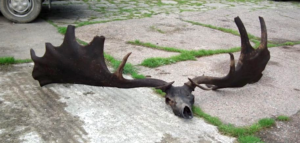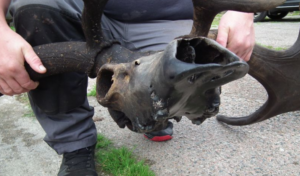The gitantic Irish elk has always fascinated me due to the immense size and fact it's extinct, which means we only can read about it but likely never will see it again.
I say likely because with DNA testing and replication and all that biological science techno stuff, it seems possible for someone to re-create one in a lab. Shades of Jurassic World, anyone? That would open some crazy doors, of course, for other species such as the woolly mammoth. But I digress.

Anglers netted this extinct Irish elk Sept. 5 while fishing in a freshwater lake in northwest Ireland. (Photo: Pat Grimes/Ardboe Heritage)
The Irish elk was found across Eurasia during the Pleistocene, the ice age that began about 2.6 million years ago and ran to 11,700 years ago. It ranged from Ireland to China. Most folks think of it as only being from Ireland, which is where most of the skeletal remains and antlers have been found, but it certainly wasn't limited to the Emerald Isle.
Can you imagine this giant animal more likely related to a fallow deer or red deer than elk, standing about 7 feet tall at the shoulder and weighing up to 1,500 pounds? Huge, no doubt. And then with antlers that could span to 12 feet?
Researchers have more data to build upon after fishermen snagged and pulled in an Irish elk skull and antlers. Raymond McElroy and Charlie Coyle were fishing about 20 feet deep in Lough Neagh, a freshwater lake.
"It came up in the net on the side of the boat. I thought it was a bit of black oak to begin with," McElroy told BelfastLive. "I was shocked to begin with when I got it over the side [of the boat] and saw the skull and antlers."

The Irish Elk was believed to stand almost 7 feet at the shoulder and weigh up to 1,500 pounds, with antlers measuring up to 12 feet wide. (Photo:Pat Grimes/Ardboe Heritage)
Pat Grimes, a local historian photographed the find, which was posted on Ardboe Gallery’s Facebook page.
Pretty incredible, no doubt. The skull and antlers were remarkably preserved after centuries of being buried in the muck at the bottom of the lake. Now researchers have more to study about this incredible beast.






